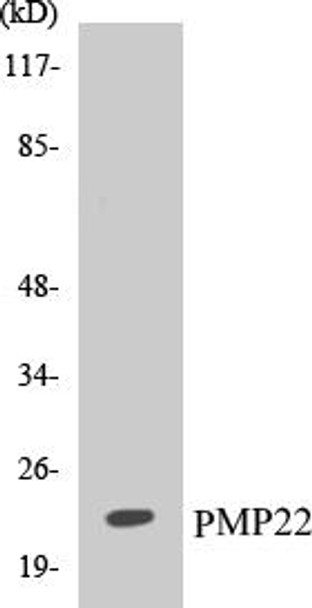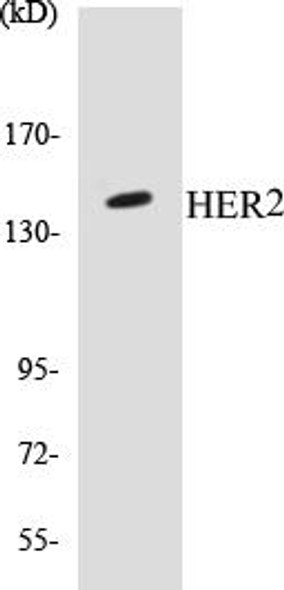Description
PMP22 Colorimetric Cell-Based ELISA Kit
The PMP22 Colorimetric Cell-Based ELISA Kit from Assay Genie is a cutting-edge tool for accurately measuring levels of the PMP22 protein in a variety of biological samples, including serum, plasma, and cell culture supernatants. With its high sensitivity and specificity, this kit delivers precise and dependable results, making it an invaluable resource for researchers across various fields.PMP22, also known as peripheral myelin protein 22, is a key player in peripheral nerve myelination and function. Abnormalities in PMP22 expression have been linked to conditions such as Charcot-Marie-Tooth disease, a hereditary neuropathy disorder.
By enabling the quantification of PMP22 levels, this kit facilitates the study of peripheral nerve disorders and the development of potential treatments.Whether investigating the role of PMP22 in neurological disorders or exploring its functions in other biological processes, the PMP22 Colorimetric Cell-Based ELISA Kit provides researchers with a reliable and user-friendly solution for their experimental needs. Trust Assay Genie for innovative tools that drive scientific discoveries forward.
| Product Name: | PMP22 Colorimetric Cell-Based ELISA |
| Product Code: | CBCAB00827 |
| ELISA Type: | Cell-Based |
| Target: | PMP22 |
| Reactivity: | Human, Mouse, Rat |
| Dynamic Range: | > 5000 Cells |
| Detection Method: | Colorimetric 450 nmStorage/Stability:4°C/6 Months |
| Format: | 96-Well Microplate |
The PMP22 Colorimetric Cell-Based ELISA Kit is a convenient, lysate-free, high throughput and sensitive assay kit that can detect PMP22 protein expression profile in cells. The kit can be used for measuring the relative amounts of PMP22 in cultured cells as well as screening for the effects that various treatments, inhibitors (ie siRNA or chemicals), or activators have on PMP22.
Qualitative determination of PMP22 concentration is achieved by an indirect ELISA format. In essence, PMP22 is captured by PMP22-specific primary antibodies while the HRP-conjugated secondary antibodies bind the Fc region of the primary antibody. Through this binding, the HRP enzyme conjugated to the secondary antibody can catalyze a colorimetric reaction upon substrate addition. Due to the qualitative nature of the Cell-Based ELISA, multiple normalization methods are needed:
| 1. | A monoclonal antibody specific for human GAPDH is included to serve as an internal positive control in normalizing the target absorbance values. |
| 2. | Following the colorimetric measurement of HRP activity via substrate addition, the Crystal Violet whole-cell staining method may be used to determine cell density. After staining, the results can be analysed by normalizing the absorbance values to cell amounts, by which the plating difference can be adjusted. |
| Database Information: | Gene ID: 5376, UniProt ID: Q01453, OMIM: 601097, Unigene: Hs.372031 |
| Gene Symbol: | PMP22 |
| Sub Type: | None |
| UniProt Protein Function: | PMP22: Might be involved in growth regulation, and in myelinization in the peripheral nervous system. Defects in PMP22 are the cause of Charcot-Marie-Tooth disease type 1A (CMT1A); also known as hereditary motor and sensory neuropathy IA. CMT1A is a form of Charcot-Marie- Tooth disease, the most common inherited disorder of the peripheral nervous system. Charcot-Marie-Tooth disease is classified in two main groups on the basis of electrophysiologic properties and histopathology: primary peripheral demyelinating neuropathy or CMT1, and primary peripheral axonal neuropathy or CMT2. Neuropathies of the CMT1 group are characterized by severely reduced nerve conduction velocities (less than 38 m/sec), segmental demyelination and remyelination with onion bulb formations on nerve biopsy, slowly progressive distal muscle atrophy and weakness, absent deep tendon reflexes, and hollow feet. CMT1A inheritance is autosomal dominant. Defects in PMP22 are a cause of Dejerine-Sottas syndrome (DSS); also known as Dejerine-Sottas neuropathy (DSN) or hereditary motor and sensory neuropathy III (HMSN3). DSS is a severe degenerating neuropathy of the demyelinating Charcot-Marie- Tooth disease category, with onset by age 2 years. DSS is characterized by motor and sensory neuropathy with very slow nerve conduction velocities, increased cerebrospinal fluid protein concentrations, hypertrophic nerve changes, delayed age of walking as well as areflexia. There are both autosomal dominant and autosomal recessive forms of Dejerine-Sottas syndrome. Defects in PMP22 are a cause of hereditary neuropathy with liability to pressure palsies (HNPP); an autosomal dominant disorder characterized by transient episodes of decreased perception or peripheral nerve palsies after slight traction, compression or minor traumas. Defects in PMP22 are the cause of Charcot-Marie-Tooth disease type 1E (CMT1E); also known as Charcot-Marie- Tooth disease and deafness autosomal dominant. CMT1E is an autosomal dominant form of Charcot-Marie-Tooth disease characterized by the association of sensorineural hearing loss with peripheral demyelinating neuropathy. Defects in PMP22 may be a cause of inflammatory demyelinating polyneuropathy (IDP). IDP is a putative autoimmune disorder presenting in an acute (AIDP) or chronic form (CIDP). The acute form is also known as Guillain-Barre syndrome. Belongs to the PMP-22/EMP/MP20 family. |
| UniProt Protein Details: | Protein type:Membrane protein, multi-pass; Cell adhesion; Cell cycle regulation; Membrane protein, integral Chromosomal Location of Human Ortholog: 17p12 Cellular Component: plasma membrane Molecular Function:protein binding Biological Process: bleb formation; cell death; peripheral nervous system development; synaptic transmission Disease: Charcot-marie-tooth Disease And Deafness; Charcot-marie-tooth Disease, Demyelinating, Type 1a; Guillain-barre Syndrome, Familial; Hypertrophic Neuropathy Of Dejerine-sottas; Neuropathy, Hereditary, With Liability To Pressure Palsies; Roussy-levy Hereditary Areflexic Dystasia |
| NCBI Summary: | This gene encodes an integral membrane protein that is a major component of myelin in the peripheral nervous system. Studies suggest two alternately used promoters drive tissue-specific expression. Various mutations of this gene are causes of Charcot-Marie-Tooth disease Type IA, Dejerine-Sottas syndrome, and hereditary neuropathy with liability to pressure palsies. Alternative splicing results in multiple transcript variants. [provided by RefSeq, Jul 2013] |
| UniProt Code: | Q01453 |
| NCBI GenInfo Identifier: | 266803 |
| NCBI Gene ID: | 5376 |
| NCBI Accession: | Q01453.1 |
| UniProt Secondary Accession: | Q01453,Q8WV01, |
| UniProt Related Accession: | Q01453 |
| Molecular Weight: | 17,891 Da |
| NCBI Full Name: | Peripheral myelin protein 22 |
| NCBI Synonym Full Names: | peripheral myelin protein 22 |
| NCBI Official Symbol: | PMP22 |
| NCBI Official Synonym Symbols: | DSS; GAS3; HNPP; CMT1A; CMT1E; GAS-3; Sp110; HMSNIA |
| NCBI Protein Information: | peripheral myelin protein 22 |
| UniProt Protein Name: | Peripheral myelin protein 22 |
| UniProt Synonym Protein Names: | Growth arrest-specific protein 3; GAS-3 |
| Protein Family: | Peripheral myelin protein |
| UniProt Gene Name: | PMP22 |
| UniProt Entry Name: | PMP22_HUMAN |
| Component | Quantity |
| 96-Well Cell Culture Clear-Bottom Microplate | 2 plates |
| 10X TBS | 24 mL |
| Quenching Buffer | 24 mL |
| Blocking Buffer | 50 mL |
| 15X Wash Buffer | 50 mL |
| Primary Antibody Diluent | 12 mL |
| 100x Anti-Phospho Target Antibody | 60 µL |
| 100x Anti-Target Antibody | 60 µL |
| Anti-GAPDH Antibody | 60 µL |
| HRP-Conjugated Anti-Rabbit IgG Antibody | 12 mL |
| HRP-Conjugated Anti-Mouse IgG Antibody | 12 mL |
| SDS Solution | 12 mL |
| Stop Solution | 24 mL |
| Ready-to-Use Substrate | 12 mL |
| Crystal Violet Solution | 12 mL |
| Adhesive Plate Seals | 2 seals |
The following materials and/or equipment are NOT provided in this kit but are necessary to successfully conduct the experiment:
- Microplate reader able to measure absorbance at 450 nm and/or 595 nm for Crystal Violet Cell Staining (Optional)
- Micropipettes with capability of measuring volumes ranging from 1 µL to 1 ml
- 37% formaldehyde (Sigma Cat# F-8775) or formaldehyde from other sources
- Squirt bottle, manifold dispenser, multichannel pipette reservoir or automated microplate washer
- Graph paper or computer software capable of generating or displaying logarithmic functions
- Absorbent papers or vacuum aspirator
- Test tubes or microfuge tubes capable of storing ≥1 ml
- Poly-L-Lysine (Sigma Cat# P4832 for suspension cells)
- Orbital shaker (optional)
- Deionized or sterile water
*Note: Protocols are specific to each batch/lot. For the correct instructions please follow the protocol included in your kit.
| Step | Procedure |
| 1. | Seed 200 µL of 20,000 adherent cells in culture medium in each well of a 96-well plate. The plates included in the kit are sterile and treated for cell culture. For suspension cells and loosely attached cells, coat the plates with 100 µL of 10 µg/ml Poly-L-Lysine (not included) to each well of a 96-well plate for 30 minutes at 37°C prior to adding cells. |
| 2. | Incubate the cells for overnight at 37°C, 5% CO2. |
| 3. | Treat the cells as desired. |
| 4. | Remove the cell culture medium and rinse with 200 µL of 1x TBS, twice. |
| 5. | Fix the cells by incubating with 100 µL of Fixing Solution for 20 minutes at room temperature. The 4% formaldehyde is used for adherent cells and 8% formaldehyde is used for suspension cells and loosely attached cells. |
| 6. | Remove the Fixing Solution and wash the plate 3 times with 200 µL 1x Wash Buffer for five minutes each time with gentle shaking on the orbital shaker. The plate can be stored at 4°C for a week. |
| 7. | Add 100 µL of Quenching Buffer and incubate for 20 minutes at room temperature. |
| 8. | Wash the plate 3 times with 1x Wash Buffer for 5 minutes each time. |
| 9. | Add 200 µL of Blocking Buffer and incubate for 1 hour at room temperature. |
| 10. | Wash 3 times with 200 µL of 1x Wash Buffer for 5 minutes each time. |
| 11. | Add 50 µL of 1x primary antibodies (Anti-PMP22 Antibody and/or Anti-GAPDH Antibody) to the corresponding wells, cover with Parafilm and incubate for 16 hours (overnight) at 4°C. If the target expression is known to be high, incubate for 2 hours at room temperature. |
| 12. | Wash 3 times with 200 µL of 1x Wash Buffer for 5 minutes each time. |
| 13. | Add 50 µL of 1x secondary antibodies (HRP-Conjugated AntiRabbit IgG Antibody or HRP-Conjugated Anti-Mouse IgG Antibody) to corresponding wells and incubate for 1.5 hours at room temperature. |
| 14. | Wash 3 times with 200 µL of 1x Wash Buffer for 5 minutes each time. |
| 15. | Add 50 µL of Ready-to-Use Substrate to each well and incubate for 30 minutes at room temperature in the dark. |
| 16. | Add 50 µL of Stop Solution to each well and read OD at 450 nm immediately using the microplate reader. |
(Additional Crystal Violet staining may be performed if desired – details of this may be found in the kit technical manual.)






